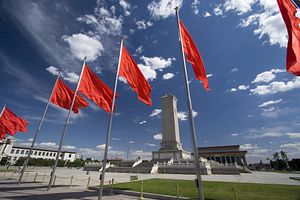After enjoying rapid development for nearly 40 years, China is at a turning point in terms of both economic growth and social development. In this series, Dr. Xue Li examines the five most critical challenges and potential pitfalls China faces today. See the first piece here.
More than 30 years have passed since China began its reform and opening up, but it has yet to create a political and social model for sustainable development.
On the economic side, by and large the market economy has taken the leading role, but there are some serious shortcomings. The government still intervenes too much in the economy. This problem of improper intervention in the economy has not been solved. To cite just two examples:
First, the stock market bears clear signs of being a policy-driven market. The recent classic example is the government’s violent intervention to rescue the market Regrettably, not only was this action ineffective, it also provided evidence to those abroad who doubt that China has a market economy. Fortunately, the government has taken note of that and is making suitable adjustments. This new recalibration very possibly will suit the needs of a market economy.
Second, restrictions on and discrimination against private sector enterprises remains a problem. Private sector enterprises already provide employment for most of China’s labor force and account for most of China’s GDP. However, many fields restrict or forbid the entry of private enterprises. The proportion of state-owned enterprises (SOEs) is too large. SOEs are less efficient and yet still often get special treatment, such as being granted monopoly status or special subsidies. This leads to unfair market conditions and to the waste and reverse flows of economic resources.
Politically, leaders at every level of China’s government have too much overall influence on the area which they govern. A change in leaders brings on a cascade of new policies — big changes in planning for economic development, in urban construction and planning, and in the bureaucratic system. Meanwhile, the problem of inadequate oversight of the top leaders at each level has not been solved. Plus, there is no mechanism for effectively constraining the growth of local debt. According to European and U.S. standards, some Chinese local governments are in fact already bankrupt.
China’s Social Stability: Political and Economic Factors
Over the past 30-plus years, several factors have made it possible for China to maintain its overall social stability. For one thing, an enormous amount of capital has been expended on maintaining social stability. However, China faces constraints how much it can increase and intensify spending on social stability. Social stability expenses already exceed military spending and there is limited room for further increases.
Another factor in China’s social stability is that officials have co-opted political, economic, and cultural elites. Political elites are given status as members of the People’s Congress or as members of the Political Consultative Congress and invited to join government leaders’ delegations visiting foreign countries. Economic elites are allowed to join the Party and even enjoy special permissions and support for their commercial activities (Geely’s purchase of Volvo is a classic example). In the academic world, elites get opportunities to participate in politics, planning, and policymaking, and thereby earn a comfortable income. Most people, and particularly elites, fear chaos. Once these elites have been co-opted into the government system through the means listed above, they generally support it.
However, the most important factor in keeping China’s social stability has been the political legitimacy that economic growth has brought with it (what we might call GDP-based legitimacy). But economic growth has a cyclical character. The Chinese economy, which has already grown rapidly for several decades, will at some point change to low growth, zero growth, or even negative growth. All this would be normal. But if there are economic issues, then there will also be political issues.
Dramatically slowed growth will create many different chain reactions in China, both from society at large (such as more mass incidents) and from within the Party. The case of the Soviet Union shows that some party cadres from rich families are always looking for opportunities to legalize and become open about their personal fortunes. This kind of attitude — that the misfortune of the country is an individual cadre’s good fortune — under certain circumstances becomes a threat to state stability. There could also be threats from outside the mainland, if the United States or even Taiwan decides to take advantage of China’s slowing growth.
Dr. Xue Li is Director of the Department of International Strategy at the Institute of World Economics and Politics, Chinese Academy of Social Sciences. Translation courtesy of Gao Dawei.

































